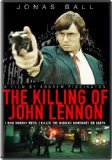| Reviews & Columns |
|
Reviews DVD TV on DVD Blu-ray 4K UHD International DVDs In Theaters Reviews by Studio Video Games Features Collector Series DVDs Easter Egg Database Interviews DVD Talk Radio Feature Articles Columns Anime Talk DVD Savant Horror DVDs The M.O.D. Squad Art House HD Talk Silent DVD
|
DVD Talk Forum |
|
|
| Resources |
|
DVD Price Search Customer Service #'s RCE Info Links |
|
Columns
|
|
|
Killing of John Lennon, The
Unless you spend a lot of time rubbing elbows with the creme de la creme of Hollywood or the music business, celebrity can be a fascinating abstraction, an intangible product that many people spend their entire lives chasing, escaping or struggling to understand. There are plenty of cinematic stabs at portraying fame and its byproducts -- Sweet Smell of Success, Sunset Boulevard or even Last Days -- but very few that slip under your skin as successfully as British writer/director Andrew Piddington's The Killing of John Lennon.
Locked into a tight, kamikaze spiral, The Killing of John Lennon unfolds as a mesmerizing portrait of insanity, pulling viewers inside the head of Mark David Chapman (Jonas Ball in a stunning performance), the man who shot ex-Beatle John Lennon dead in the hallway of his New York City apartment building on Dec. 8, 1980. What's most remarkable is the way that Piddington, who shot the film in the actual locations where these events transpired and used Chapman's own words, manages to tell this story without ever passing judgment on Chapman or his actions. It's a remarkably even-handed treatment of polarizing subject matter.
There are inescapable allusions to Martin Scorsese's Taxi Driver (which even Piddington admits in the commentary track) and the isolated-man-adrift-in-modern-society theme strongly evokes the classic films of the Seventies. The Killing of John Lennon unfolds over the course the months leading up to Chapman and Lennon's fateful meeting, tracing the gradual disintegration of Chapman's life as a security guard in Honolulu, Hawaii and the circumstances that led him to leave the island and fly to the mainland, pursuing an audience with Lennon while clutching his copy of J.D. Salinger's "The Catcher in the Rye." Piddington doesn't stop there -- he takes viewers through the killing and into the beginning of Chapman's incarceration, which provides a slight sense of closure.
The decision to shoot the film on location was probably the smartest thing Piddington could have done -- it gives the images a remarkably eerie, dream-like quality (although Chapman had a moment in Times Square, it obviously looks nothing now like it did then) that makes the story seem unstuck in time somehow. Nevertheless, it's a powerful effect, one which complements Ball's tremendous performance as Chapman; what could have easily collapsed into easy caricature has the air of lethal seriousness. It's a masterful piece of acting and arguably, makes The Killing of John Lennon a one-man show.
Of course, the subject matter ensures that this is not a light-hearted affair, but rather a grim dissection of madness, as touched by celebrity and sheer mental breakdown. Having not yet seen writer/director J.P. Schafer's Chapter 27, the other, seemingly more flashy depiction of Chapman and his murder of Lennon, I can't speak to which is more successful - although I can't imagine Jared Leto outshining Jonas Ball. Hopefully, those intrigued by this sad chapter in history will seek this film out instead and then work their way over to Chapter 27.
Piddington begins fragmenting time, color and sound towards the film's conclusion, letting the world fracture just a little bit more and holding viewers captive as one man's sanity finally, fully evaporates. The Killing of John Lennon is one of the most powerful films in recent memory and deserves to be sought out.
The DVDThe Video:
Presented in its original theatrical aspect ratio of 2.35:1, this anamorphic widescreen transfer is not without its rough patches, but that owes more to the source material (some sequences of The Killing of John Lennon were filmed on 8 mm) and the countless low-light scenes that comprise the film's narrative. The grittiness and griminess of the images gives the film an extra spark.
The Audio:The Dolby Digital 5.1 track shines throughout, conveying dialogue, score and myriad sound effects without ever slipping into distorted mush. Chapman's interior monologue has a satisfying weight, while the evocative score and the kaleidoscope of ambient sounds fills in nicely. Optional English and Spanish subtitles are included.
The Extras:Piddington contributes a very hushed, informative commentary track that outlines the challenges of shooting on location, as well as some of the psychological aspects of re-creating Chapman and his thoughts on the finished product. An involving listen and well worth fans of the film's time. Fourteen deleted scenes (presented in non-anamorphic widescreen) are included, playable separately or all together for an aggregate of 33 minutes, 45 seconds and the film's theatrical trailer (presented in anamorphic widescreen) completes the disc.
Final Thoughts:Of course, the subject matter ensures that this is not a light-hearted affair, but rather a grim dissection of madness, as touched by celebrity and sheer mental breakdown. Writer/director Andrew Piddington begins fragmenting time, color and sound towards the film's conclusion, letting the world fracture just a little bit more and holding viewers captive as one man's sanity finally, fully evaporates. The Killing of John Lennon is one of the most powerful films in recent memory and deserves to be sought out. Highly recommended.
|
| Popular Reviews |
| Sponsored Links |
|
|
| Sponsored Links |
|
|
| Release List | Reviews | Shop | Newsletter | Forum | DVD Giveaways | Blu-Ray | Advertise |
|
Copyright 2024 DVDTalk.com All Rights Reserved. Legal Info, Privacy Policy, Terms of Use,
Manage Preferences,
Your Privacy Choices | |||||||













